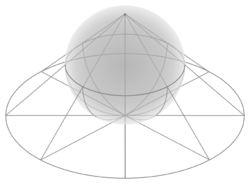One-dimensional space
| Geometry |
|---|
 |
| Geometers |
A one-dimensional space (1D space) is a mathematical space in which location can be specified with a single coordinate. An example is the number line, each point of which is described by a single real number.[1]
Any straight line or smooth curve is a one-dimensional space, regardless of the dimension of the ambient space in which the line or curve is embedded. Examples include the circle on a plane, or a parametric space curve.
In algebraic geometry there are several structures that are one-dimensional spaces but are usually referred to by more specific terms. Any field [math]\displaystyle{ K }[/math] is a one-dimensional vector space over itself. The projective line over [math]\displaystyle{ K, }[/math] denoted [math]\displaystyle{ \mathbf P^1(K), }[/math] is a one-dimensional space. In particular, if the field is the complex numbers [math]\displaystyle{ \mathbb{C}, }[/math] then the complex projective line [math]\displaystyle{ \mathbf P^1(\mathbb{C}) }[/math] is one-dimensional with respect to [math]\displaystyle{ \mathbb{C} }[/math] (but is sometimes called the Riemann sphere, as it is a model of the sphere, two-dimensional with respect to real-number coordinates).
For every eigenvector of a linear transformation T on a vector space V, there is a one-dimensional space A ⊂ V generated by the eigenvector such that T(A) = A, that is, A is an invariant set under the action of T.[2]
In Lie theory, a one-dimensional subspace of a Lie algebra is mapped to a one-parameter group under the Lie group–Lie algebra correspondence.[3]
More generally, a ring is a length-one module over itself. Similarly, the projective line over a ring is a one-dimensional space over the ring. In case the ring is an algebra over a field, these spaces are one-dimensional with respect to the algebra, even if the algebra is of higher dimensionality.
Coordinate systems in one-dimensional space
One dimensional coordinate systems include the number line.
See also
References
- ↑ Гущин, Д. Д.. "Пространство как математическое понятие" (in ru). fmclass.ru. http://fmclass.ru/math.php?id=49a0390719b7b.
- ↑ Peter Lancaster & Miron Tismenetsky (1985) The Theory of Matrices, second edition, page 147, Academic Press ISBN:0-12-435560-9
- ↑ P. M. Cohn (1961) Lie Groups, page 70, Cambridge Tracts in Mathematics and Mathematical Physics # 46
 |


